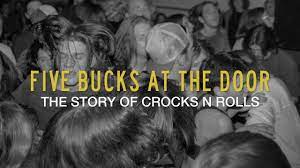 |
| Frank Loffredo photo by Brent Linton |
The Story of Crocks N Rolls
Directed by Kirsten Kosloski
I once co-wrote a book about Canadian music from 1985-95. It talked about a lot of people, a lot of places from coast to coast. After watching Kirsten Kosloski’s new documentary Five Bucks at the Door (link to full film below), I realize I could have set the entire book in Thunder Bay, at a bar called Crocks N Rolls. The main character, as it is in the film, would be the club’s owner, Frank Loffredo.
If you were a touring Canadian musician in the late '80s and early '90s, you played at Crocks N Rolls. You had to. The distance between Toronto and Winnipeg is 21 hours. Sudbury and Winnipeg: 18 hours. Hell, even between Sault Ste. Marie and Winnipeg is 14 hours. You have to stop in Thunder Bay.
Kosloski grew up as a nerdy, shy kid who taped CBC’s Brave New Waves late at night and listened to it on the bus to school the next day--so she’s already someone after my own heart. The first night she goes to Crocks N Rolls, when she’s 16, her life changes. The fact that she was allowed in is itself a miracle: all-ages shows in bars were hardly the norm anywhere else in Canada. (I had to grow a beard to have a similar experience in Toronto, at the same age.) There, she sees all kinds of freaks: NoMeansNo, Bob’s Your Uncle, Jr. Gone Wild, Change of Heart, Bob Wiseman, Rheostatics, the Inbreds, 13 Engines, Furnaceface, Acid Test. Years later, she interviews them all for her film.
Even if I didn’t write a similar book, can I possibly be objective about this film? I’m between the ages of 45 and 55, had my life changed by Brave New Waves, went to see way too much live music, and my main goal in life when I was 25 was to tour Canada. Which I did--but Crocks N Rolls happened to close the very week my band left on tour. So we drove from Sudbury to our next gig… in Regina (ouch). But the fact I never entered its doors doesn’t diminish the effect this film has on me. This is as nostalgic as I can possibly feel about a place I’ve never been to.
This film is clearly a love letter to the wonderfully weird side of Thunder Bay (which is a welcome respite from the avalanche of horror stories out of the city in recent years; for better or worse, that aspect of the city is not addressed here). The queers, the punks, the metalheads, the jam bands, the tree-planters: all were welcome, with girls to the front. But it’s also an ideal microcosm for every Canadian city that isn’t Montreal, Toronto or Vancouver. If you’re lucky, your town had that one club, or one arts space, or one radio station or record store, that acts as a hub, a lifeline and a pipeline to the outside world. Some use it as a launching pad for escape; some use it to empower a local existence. God bless those like Loffredo, who stick around, who make something happen, who don’t give up on the place that they live.
Kosloski brings the story to life not just with candid chats with Loffredo and the artists mentioned above, but with a wealth of photos and original animation. She also puts herself in front of the camera, a technique I normally find grating unless absolutely necessary--which she is. She’s the heart of this story, even more so than Loffredo; without her testimonial, his story would be far less effective. And her (perhaps too long) tribute to Brave New Waves is perfect (and therefore not a single second too long): the national radio show helped her imagine a bigger world, and Crocks N Rolls brought it to her directly. I grew up in a suburb of the biggest city in the country, and even I know what it feels like to find those lifelines. She makes a strong case for how much more important those things are when the next town is an eight-hour drive in any direction.

I loved this film. If you’ve read either Have Not Been the Same or The Never-Ending Present, or listened to Brave New Waves during the Brent Bambury years, or watched Bruce McDonald's trilogy of Roadkill / Highway 61 / Hard Core Logo, I can guarantee you’ll love it as well. (You’re also likely to be a dear friend of mine.)
I have a few minor quibbles: there’s some minor repetition in the storytelling (not uncommon in current docs), and there’s some Thunder Bay inside baseball that’s not fully explained: Who is that guy? Why was his band important? But to be fair, those locals don’t resonate for me only because I know all the other talking heads extremely well, some of them personally. If you came to this film cold--as a mainstream music fan, as a non-Canadian, or even as a Canadian under 40--the composite portrait is still effective. And while obviously it would be great to have had more video footage, Kosloski does a fantastic job with photographs--and the fact she doesn’t have much video makes the whole time period seem further away than it actually is, therefore more exotic. (The amazing photos, by Brent Linton, are in vivid B&W.)
It’s such a tired cliche of historians talking about events from 30 years ago to provide qualifiers about how “of course, this was pre-Internet”--but it’s a tired cliche that’s entirely necessary, especially here. This really does seem like ancient history now. As Sook-Yin Lee points out in the film, it’s ephemera in dire danger of fading away entirely.
Maybe the story of Crocks N Rolls says it all.
A Calgary Herald story by Eric Volmers is here.

